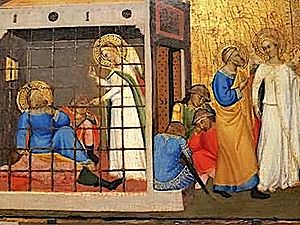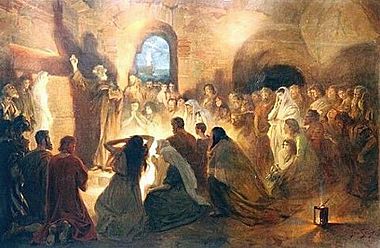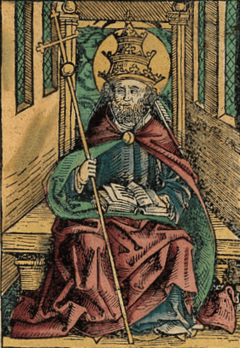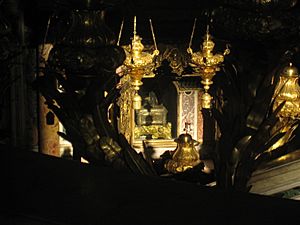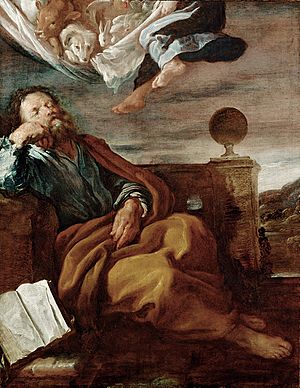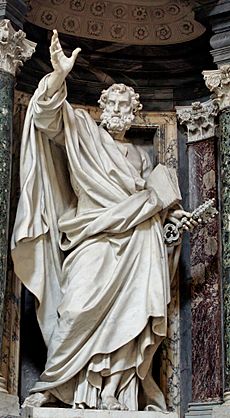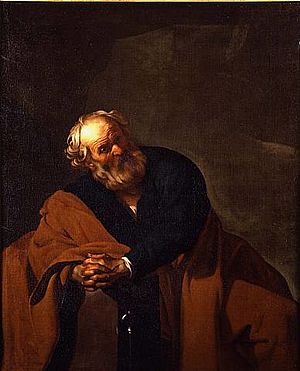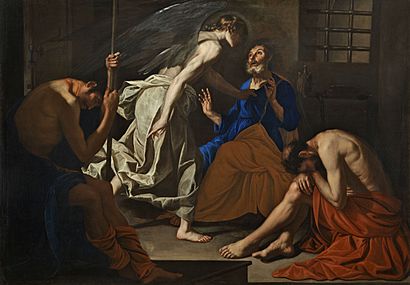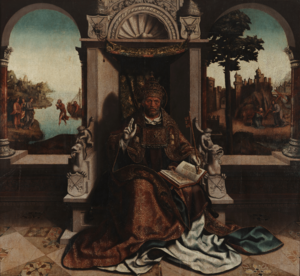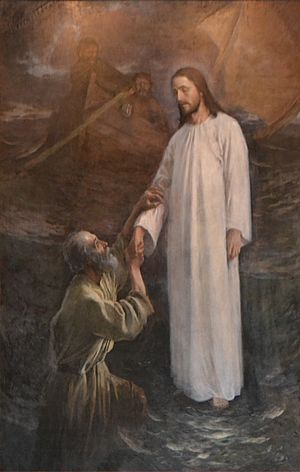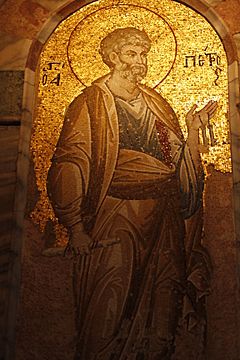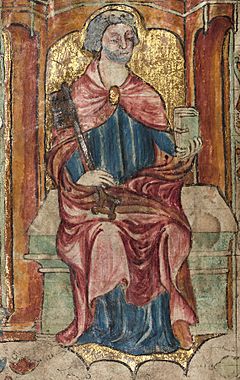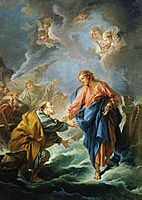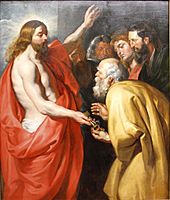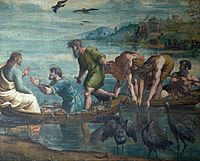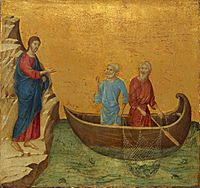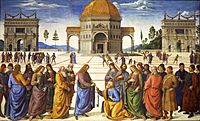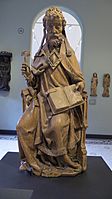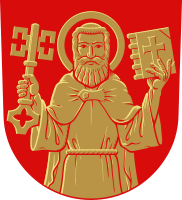Saint Peter facts for kids
Quick facts for kids Saint Peter the Apostle |
|
|---|---|
|
|
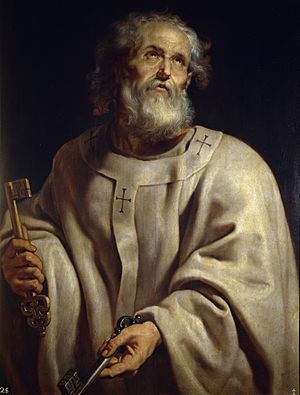
Saint Peter (c. 1610–1612) by Peter Paul Rubens, depicting Peter, vested in the pallium, and holding the Keys of Heaven.
|
|
| Church | Early Christian |
| See |
|
| Papacy began | AD 30 |
| Papacy ended | Between AD 64–68 |
| Successor |
|
| Personal details | |
| Birth name | Shimon Bar Yonah (Hebrew: שמעון בר יונה) (Simeon, Simon) |
| Born | c. AD 1 Bethsaida, Gaulanitis, Syria, Roman Empire |
| Died | Between AD 64–68 probably Vatican Hill, Rome, Italia, Roman Empire |
| Parents | John (or Jonah; Jona) |
| Occupation | Fisherman, clergyman |
| Sainthood | |
| Feast day |
|
| Venerated in | All Christian denominations that venerate saints and in Islam |
| Canonized | Pre-Congregation |
| Attributes | Keys of Heaven, Red Martyr, pallium, papal vestments, man crucified upside down, vested as an Apostle, holding a book or scroll, Cross of Saint Peter |
| Patronage | Patronage list |
| Shrines | St. Peter's Basilica |
Saint Peter (died between AD 64 and 68), also known as Peter the Apostle, Simon Peter, Simeon, Simon, or Cephas (lit. 'rock'), was one of the Twelve Apostles of Jesus Christ and one of the first leaders of the early Christian Church.
According to Christian tradition, Peter was crucified in Rome under Emperor Nero. The ancient Christian churches all venerate Peter as a major saint and as the founder of the Church of Antioch and the Church of Rome, but they differ in their attitudes regarding the authority of his successors. According to Catholic teaching, Jesus promised Peter a special position in the Church. In the New Testament, the name "Simon Peter" is found 19 times. He appears repeatedly and prominently in all four gospels as well as the Acts of the Apostles. He is the brother of Saint Andrew, and both were fishermen. The Gospel of Mark in particular was traditionally thought to show the influence of Peter's preaching and eyewitness memories. He is also mentioned, under either the name Peter or Cephas, in Paul's First Letter to the Corinthians and the Epistle to the Galatians. The New Testament also includes two general epistles, First Peter and Second Peter, that are traditionally attributed to him, but modern scholarship generally rejects the Petrine authorship of both. Nevertheless, Evangelicals and Catholics have always affirmed Peter's authorship, and recently, a growing number of scholars have revived the claim of Petrine authorship of these epistles.
Catholic and Orthodox tradition accredits him as the first bishop of Rome—or pope—and also as the first bishop of Antioch. Based on contemporary historical data, his papacy is estimated to have spanned from AD 30 to his death, which would make him the longest-reigning pope, at anywhere from 34 to 38 years; however, this has never been verified.
Saint Irenaeus (c.130-202 AD) explains the Apostle Peter, his See, and his successors in book III of Adversus Haereses (Against Heresies). In the book, Irenaeus wrote that Peter and Paul founded and organized the Church in Rome.
Sources suggest that at first, the terms episcopos and presbyter were used interchangeably, with the consensus among scholars being that by the turn of the 1st and 2nd centuries, local congregations were led by bishops and presbyters, whose duties of office overlapped or were indistinguishable from one another. Protestant and secular historians generally agree that there was probably "no single 'monarchical' bishop in Rome before the middle of the 2nd century...and likely later." Outside of the New Testament, several apocryphal books were later attributed to him, in particular the Acts of Peter, Gospel of Peter, Preaching of Peter, Apocalypse of Peter, and Judgment of Peter, although scholars believe these works to be pseudepigrapha.
Contents
Names and etymologies
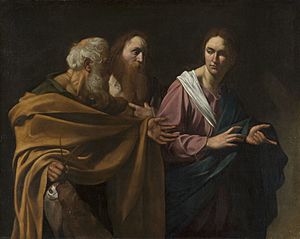
The New Testament presents Peter's original name as Simon (Σίμων, Simōn in Greek). In only two passages, his name is instead spelled "Simeon" (Συμεών in Greek). The variation possibly reflects "the well-known custom among Jews at the time of giving the name of a famous patriarch or personage of the Old Testament to a male child [i.e., Simeon] along with a similar sounding Greek/Roman name [in this case, Simon]".
He was later given by Jesus the name Cephas, from the Aramaic כֵּיפָא, Kepha, 'rock/stone'. In translations of the Bible from the original Greek, his name is maintained as Cephas in 9 occurrences in the New Testament, whereas in the vast majority of mentions (156 occurrences in the New Testament) he is called Πέτρος, Petros, from the Greek and Latin word for a rock or stone (petra) to which the masculine ending was added, rendered into English as Peter.
The precise meaning of the Aramaic word is disputed, some saying that its usual meaning is "rock" or "crag", others saying that it means rather "stone" and, particularly in its application by Jesus to Simon, like a "jewel", but most scholars agree that as a proper name it denotes a rough or tough character. Both meanings, "stone" (jewel or hewn stone) and "rock", are indicated in dictionaries of Aramaic and Syriac.
Catholic theologian Rudolf Pesch argues that the Aramaic word Cephas would mean "precious stone" to designate a distinguishing person. This cannot be sufficiently proven from Aramaic, however, since the use of the Aramaic root kp as a personal name has not been proven and there are hardly any known examples of the word being used to mean "precious stone".
The combined name Σίμων Πέτρος (Símon Pétros, Simon Peter) appears 19 times in the New Testament. In some Syriac documents he is called, in English translation, Simon Cephas.
Biographical information
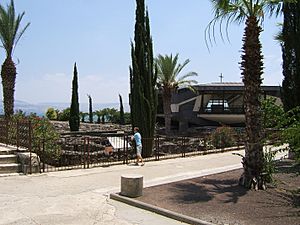
Sources
The sources used to reconstruct the life of Peter can be divided in three groups:
- the New Testament writings, such as the Pauline Epistles (where Paul the Apostle calls him "Cephas" and "Peter"), the Petrine Epistles (traditionally attributed to him, but their authorship is disputed), the Canonical Gospels and the Acts of the Apostles;
- the New Testament apocrypha attributed to him, such as the Gospel of Peter, the Preaching of Peter, the Acts of Peter, the Acts of Peter and Andrew, the Acts of Peter and the Twelve, the Acts of Peter and Paul, the Letter of Peter to Philip, the Letter of Peter to James the Just, the Apocalypse of Peter and the Coptic Apocalypse of Peter. Scholars agree that these are late pseudepigrapha with little historical value, though they may contain some historical kernel;
- the writing of the Apostolic Fathers and the Church Fathers, such as Papias of Hierapolis, Pope Clement I, Polycarp, Ignatius of Antioch and Ireneus.
In the New Testament, he is among the first of the disciples called during Jesus' ministry. Peter became the first listed apostle ordained by Jesus in the early Church.
Accounts
Peter was a Jewish fisherman in Bethsaida (John 1:44). He was named Simon, the son of a man named Jonah or John. The three Synoptic Gospels recount how Peter's mother-in-law was healed by Jesus at their home in Capernaum (Matthew 8:14–17, Mark 1:29–31, Luke 4:38); this passage clearly depicts Peter as being married or widowed. 1 Corinthians 9:5 has also been taken to imply that he was married.
In the Synoptic Gospels, Peter (then Simon) was a fisherman along with his brother, Andrew, and the sons of Zebedee, James and John. The Gospel of John also depicts Peter fishing, even after the resurrection of Jesus, in the story of the Catch of 153 fish. In Matthew and Mark, Jesus called Simon and his brother Andrew to be "fishers of men" (Matthew 4:18–19, Mark 1:16–17).
In the Confession of Peter he proclaims Jesus to be the Christ (Jewish Messiah), as described in the three Synoptic Gospels: Matthew 16:13–20, Mark 8:27–30 and Luke 9:18–21. It is there, in the area of Caesarea Philippi, that he receives from Jesus the name Cephas (Aramaic Kepha), or Peter (Greek Petros).
In Luke, Simon Peter owns the boat that Jesus uses to preach to the multitudes who were pressing on him at the shore of Lake Gennesaret (Luke 5:3). Jesus then amazes Simon and his companions James and John (Andrew is not mentioned) by telling them to lower their nets, whereupon they catch a huge number of fish. Immediately after this, they follow him (Luke 5:4–11). The Gospel of John gives a comparable account of "The First Disciples" (John 1:35–42). In John, the readers are told that it was two disciples of John the Baptist (Andrew and an unnamed disciple) who heard John the Baptist announce Jesus as the "Lamb of God" and then followed Jesus. Andrew then went to his brother Simon, saying, "We have found the Messiah", and then brought Simon to Jesus.
Three of the four gospels—Matthew, Mark and John—recount the story of Jesus walking on water. Matthew additionally describes Peter walking on water for a moment but beginning to sink when his faith wavers (Matthew 14:28–31).
At the beginning of the Last Supper, Jesus washed his disciples' feet. Peter initially refused to let Jesus wash his feet, but when Jesus told him: "If I wash thee not, thou hast no part with me", Peter replied: "Lord, not my feet only, but also my hands and my head" (John 13:2–11). The washing of feet is often repeated in the service of worship on Maundy Thursday by some Christian denominations.
The three Synoptic Gospels all mention that, when Jesus was arrested, one of his companions cut off the ear of a servant of the High Priest of Israel (Matthew 26:51, Mark 14:47, Luke 22:50). The Gospel of John also includes this event and names Peter as the swordsman and Malchus as the victim (John 18:10). Luke adds that Jesus touched the ear and miraculously healed it (Luke 22:49–51). This healing of the servant's ear is the last of the 37 miracles attributed to Jesus in the Bible.
Simon Peter was twice arraigned, with John, before the Sanhedrin and directly defied them (Acts 4:7–22, Acts 5:18–42). After receiving a vision from God that allowed for the eating of previously unclean animals, Peter takes a missionary journey to Lydda, Joppa and Caesarea (Acts 9:32–Acts 10:2), becoming instrumental in the decision to evangelise the Gentiles (Acts 10). Simon Peter applied the message of the vision on clean animals to the gentiles and follows his meeting with Cornelius the Centurion by claiming that "God shows no partiality".
According to the Acts of the Apostles, Peter and John were sent from Jerusalem to Samaria (Acts 8:14). Peter/Cephas is mentioned briefly in the opening chapter of one of the Pauline epistles, Epistle to the Galatians, which mentions a trip by Paul the Apostle to Jerusalem where he meets Peter (Galatians 1:18). Peter features again in Galatians, fourteen years later, when Paul (now with Barnabas and Titus) returned to Jerusalem (Galatians 2:7–9). When Peter came to Antioch, Paul opposed Peter to his face "because he [Peter] was in the wrong" (Galatians 2:11).
Acts 12 narrates how Peter, who was in Jerusalem, was put into prison by Agrippa I (AD 42–44), but was rescued by an angel. After his liberation Peter left Jerusalem to go to "another place" (Acts 12:1–18). Concerning Peter's subsequent activity there is no further connected information from the extant sources, although there are short notices of certain individual episodes of his later life.
First leader of the early Church
The Gospels and Acts portray Peter as the most prominent apostle, though he denied Jesus three times during the events of the crucifixion. According to the Christian tradition, Peter was the first disciple to whom Jesus appeared, balancing Peter's denial and restoring his position. Peter is regarded as the first leader of the early Church, though he was soon eclipsed in this leadership by James the Just, "the Brother of the Lord". Because Peter was the first to whom Jesus appeared, the leadership of Peter forms the basis of the Apostolic succession and the institutional power of orthodoxy, as the heirs of Peter, and he is described as "the rock" on which the church will be built.
Position among the apostles
Peter is always listed first among the Twelve Apostles in the Gospels and in the Book of Acts. Along with James the Elder and John he formed an informal triumvirate within the Twelve Apostles. Jesus allowed them to be the only apostles present at three particular occasions during his public ministry, the Raising of Jairus' daughter[Mark 5:37], Transfiguration of Jesus [Matthew 17:1] and Agony in the Garden of Gethsemane[Matthew 26:37]. Peter often confesses his faith in Jesus as the Messiah.
Peter is often depicted in the gospels as spokesman of all the Apostles. John Vidmar, a Catholic scholar, writes: "Catholic scholars agree that Peter had an authority that superseded that of the other apostles. Peter is their spokesman at several events, he conducts the election of Matthias, his opinion in the debate over converting Gentiles was crucial, etc."
The author of the Acts of the Apostles portrays Peter as the central figure within the early Christian community.
Denial of Jesus by Peter
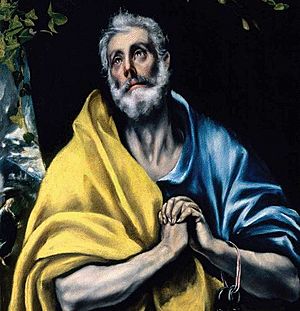
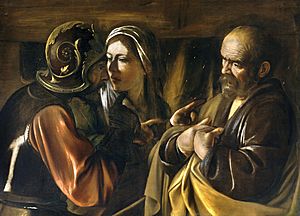
All four canonical gospels recount that, during the Last Supper, Jesus foretold that Peter would deny him three times before the following cockcrow ("before the cock crows twice" in Mark's account). The three Synoptics and John describe the three denials as follows:
- A denial when a female servant of the high priest spots Simon Peter, saying that he had been with Jesus. According to Mark (but not in all manuscripts), "the rooster crowed". Only Luke and John mention a fire by which Peter was warming himself among other people: according to Luke, Peter was "sitting"; according to John, he was "standing".
- A denial when Simon Peter had gone out to the gateway, away from the firelight, but the same servant girl (per Mark) or another servant girl (per Matthew) or a man (per Luke and also John, for whom, though, this is the third denial) told the bystanders he was a follower of Jesus. According to John, "the rooster crowed". The Gospel of John places the second denial while Peter was still warming himself at the fire, and gives as the occasion of the third denial a claim by someone to have seen him in the garden of Gethsemane when Jesus was arrested.
- A denial came when Peter's Galilean accent was taken as proof that he was indeed a disciple of Jesus. According to Matthew, Mark and Luke, "the rooster crowed". Matthew adds that it was his accent that gave him away as coming from Galilee. Luke deviates slightly from this by stating that, rather than a crowd accusing Simon Peter, it was a third individual. John does not mention the Galilean accent.
In the Gospel of Luke is a record of Christ telling Peter: "Simon, Simon, behold, Satan hath desired to have you, that he may sift you as wheat: but I have prayed for thee, that thy faith fail not: and when thou art converted, strengthen thy brethren." In a reminiscent scene in John's epilogue, Peter affirms three times that he loves Jesus.
Resurrection appearances
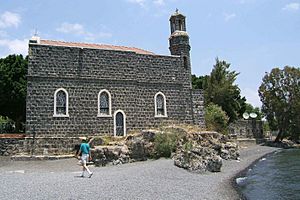
Paul's First Epistle to the Corinthians contains a list of resurrection appearances of Jesus, the first of which is an appearance to Peter. Here, Paul apparently follows an early tradition that Peter was the first to see the risen Christ, which, however, did not seem to have survived to the time when the gospels were written.
In John's gospel, Peter is the first person to enter the empty tomb, although the women and the beloved disciple see it before him.[Jn. 20:1–9] In Luke's account, the women's report of the empty tomb is dismissed by the apostles, and Peter is the only one who goes to check for himself, running to the tomb. After seeing the graveclothes he goes home, apparently without informing the other disciples.[Lk. 24:1–12]
In the final chapter of the Gospel of John, Peter, in one of the resurrection appearances of Jesus, three times affirmed his love for Jesus, balancing his threefold denial, and Jesus reconfirmed Peter's position. The Church of the Primacy of St. Peter on the Sea of Galilee is seen as the traditional site where Jesus Christ appeared to his disciples after his resurrection and, according to Catholic tradition, established Peter's supreme jurisdiction over the Christian church.
Leader of the early Church
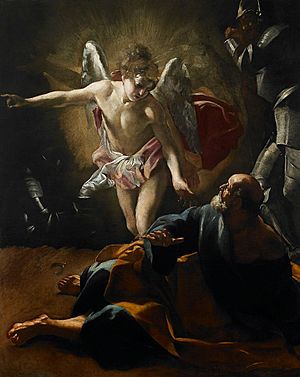
Peter was considered along with James the Just and John the Apostle as pillars of the Church. Legitimised by Jesus' appearance, Peter assumed leadership of the group of early followers, forming the Jerusalem ekklēsia mentioned by Paul. He was soon eclipsed in this leadership by James the Just, "the Brother of the Lord." According to Lüdemann, this was due to the discussions about the strictness of adherence to the Jewish Law, when the more conservative faction of James the Just took the overhand over the more liberal position of Peter, who soon lost influence. According to Dunn, this was not an "usurpation of power", but a consequence of Peter's involvement in missionary activities. The early Church historian Eusebius (c. AD 325) records Clement of Alexandria (c.
Paul affirms that Peter had the special charge of being apostle to the Jews, just as he, Paul, was apostle to the Gentiles. Some argue James the Just was bishop of Jerusalem whilst Peter was bishop of Rome and that this position at times gave James privilege in some (but not all) situations.
"Rock" dialogue
In a dialogue between Jesus and his disciples (Matthew 16:13–19), Jesus asks, "Who do people say that the Son of Man is?" The disciples give various answers. When he asks "Who do you say that I am?", Simon Peter answers, "You are the Messiah, the Son of the living God."
A common view of Peter is provided by Jesuit Father Daniel J. Harrington, who suggests that Peter was an unlikely symbol of stability. While he was one of the first disciples called and was the spokesman for the group, Peter is also the exemplar of "little faith". In Matthew 14, Peter will soon have Jesus say to him, "O you of little faith, why did you doubt?", and he will eventually deny Jesus three times. Thus, in light of the Easter event, Peter became an exemplar of the forgiven sinner. Outside the Catholic Church, opinions vary as to the interpretation of this passage with respect to what authority and responsibility, if any, Jesus was giving to Peter.
In the Eastern Orthodox Church this passage is interpreted as not implying a special prominence to the person of Peter, but to Peter's position as representative of the Apostles. The word used for "rock" (petra) grammatically refers to "a small detachment of the massive ledge", not to a massive boulder. Thus, Orthodox Sacred Tradition understands Jesus' words as referring to the apostolic faith.
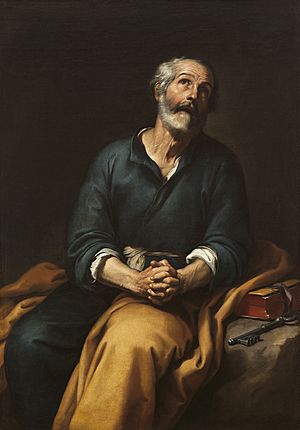
Petros had not previously been used as a name, but in the Greek-speaking world it became a popular Christian name, after the tradition of Peter's prominence in the early Christian church had been established.
Apostolic succession
The leadership of Peter forms the basis of the Apostolic succession and the institutional power of orthodoxy, as the heirs of Peter, and is described as "the rock" on which the church will be built. Catholics refer to him as chief of the Apostles, as do the Eastern Orthodox and the Oriental Orthodox. In Coptic Orthodox Church liturgy, he is once referred to as "prominent" or "head" among the Apostles, a title shared with Paul in the text (The Fraction of Fast and Feast of the Apostles Peter and Paul in the Coptic Orthodox Church of Alexandria). Some, including the Orthodox Churches, believe this is not the same as saying that the other Apostles were under Peter's orders.
Antioch and Corinth
Antioch
According to the Epistle to the Galatians ({{{3}}}), Peter went to Antioch where Paul rebuked him for following the conservative line regarding the conversion of Gentiles, having meals separate from Gentiles. Subsequent tradition held that Peter had been the first Patriarch of Antioch. According to the writings of Origen and Eusebius in his Church History (III, 36) Peter had founded the church of Antioch.
Later accounts expand on the brief biblical mention of his visit to Antioch. The Liber Pontificalis (9th century) mentions Peter as having served as bishop of Antioch for seven years, and having potentially left his family in the Greek city before his journey to Rome. Claims of direct blood lineage from Simon Peter among the old population of Antioch existed in the 1st century and continue to exist today, notably by certain Semaan families of modern-day Syria and Lebanon. Historians have furnished other evidence of Peter's sojourn in Antioch.
The Clementine literature, a group of related works written in the fourth century but believed to contain materials from earlier centuries, relate information about Peter that may come from earlier traditions. One is that Peter had a group of 12 to 16 followers, whom the Clementine writings name. Another is that it provides an itinerary of Peter's route from Caesarea Maritima to Antioch, where he debated his adversary Simon Magus; during this journey he ordained Zacchaeus as the first bishop of Caesarea and Maro as the first bishop of Tripolis. Fred Lapham suggests the route recorded in the Clementine writings may have been taken from an earlier document mentioned by Epiphanius of Salamis in his Panarion called "The Itinerary of Peter".
Corinth
Peter may have visited Corinth, and maybe there existed a party of "Cephas". First Corinthians suggests that perhaps Peter visited the city of Corinth, located in Greece, during their missions.[1Cor. 1:12]
Dionysius, bishop of Corinth, in his Epistle to the Roman Church under Pope Soter (A.D.
Connection to Rome
In a tradition of the early Church, Peter is said to have founded the Church in Rome with Paul, served as its bishop, authored two epistles, and then met martyrdom there along with Paul.
Papacy
The Catholic Church speaks of the pope, the bishop of Rome, as the successor of Saint Peter. This is often interpreted to imply that Peter was the first Bishop of Rome. However, it is also said that the institution of the papacy is not dependent on the idea that Peter was Bishop of Rome or even on his ever having been in Rome.
According to book III, chapter 3 of Against Heresies (180 AD), Linus was named as Peter's successor and is recognized by the Catholic church as the second Bishop of Rome (pope), followed by Anacletus, Clement of Rome, Evaristus, Alexander, Sixtus, Telephorus, Hyginus, Pius, Anicetus, Soter and Eleutherius.
St. Clement of Rome identifies Peter and Paul as the outstanding heroes of the faith.
Coming to Rome
New Testament accounts
There is no obvious biblical evidence that Peter was ever in Rome, but the first epistle of Peter does mention that "The church that is at Babylon, elected together with you, saluteth you; and so doth Marcus my son." It is not certain whether this refers to the actual Babylon or to Rome, for which Babylon was a common nickname at the time, or to the Jewish diaspora in general, as a recent theory has proposed.
Paul's Epistle to the Romans, written about AD 57. greets some fifty people in Rome by name, but not Peter whom he knew. There is also no mention of Peter in Rome later during Paul's two-year stay there in Acts 28, about AD 60–62. With regards to the latter, Acts 28 does not specifically mention any of Paul's visitors.
Church Fathers
The writings of the 1st century Church Father Ignatius of Antioch (c. 35 – c. 107) refer to Peter and Paul giving admonitions to the Romans, indicating Peter's presence in Rome.
Irenaeus of Lyons (c. 130 – c. 202) wrote in the 2nd century that Peter and Paul had been the founders of the Church in Rome and had appointed Linus as succeeding bishop.
Clement of Alexandria (c. 150 – c. 215) states that "Peter had preached the Word publicly at Rome (A.D. 190)."
According to Origen (184–253) and Eusebius, Peter "after having first founded the church at Antioch, went away to Rome preaching the Gospel, and he also, after [presiding over] the church in Antioch, presided over that of Rome until his death". After presiding over the church in Antioch for a while, Peter would have been succeeded by Evodius and thereafter by Ignatius, who was a disciple of John the Apostle.
Lactantius, in his book called Of the Manner in Which the Persecutors Died, written around 318, noted that "and while Nero reigned, the Apostle Peter came to Rome, and, through the power of God committed unto him, wrought certain miracles, and, by turning many to the true religion, built up a faithful and stedfast temple unto the Lord."
Simon Magus
Eusebius of Caesarea (260/265–339/340) relates that when Peter confronts Simon Magus at Judea (mentioned in Acts 8), Simon Magus flees to Rome, where the Romans began to regard him as a god. According to Eusebius, his luck did not last long, since God sent Peter to Rome, and Simon was quenched and immediately destroyed.
According to Jerome (327–420): "Peter went to Rome in the second year of Claudius to overthrow Simon Magus, and held the sacerdotal chair there for twenty-five years until the last, that is the fourteenth, year of Nero."
An apocryphal work, the Actus Vercellenses (7th century), a Latin text preserved in only one manuscript copy published widely in translation under the title Acts of Peter, sets Peter's confrontation with Simon Magus in Rome.
Death and burial
Crucifixion at Rome
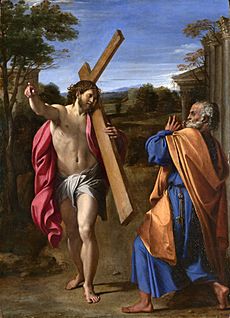
In the epilogue of the Gospel of John, Jesus hints at the death by which Peter would glorify God, saying: "when you are old you will stretch out your hands, and another will dress you and carry you where you do not want to go." This is interpreted by some as a reference to Peter's crucifixion. Theologians Donald Fay Robinson and Warren M. Smaltz have suggested that the incident in Acts 12:1–17, where Peter is "released by an angel" and goes to "another place", really represents an idealized account of his death, which may have occurred in a Jerusalem prison as early as AD 44.
Early Church tradition says that Peter died by crucifixion (with arms outstretched) at the time of the Great Fire of Rome in the year 64. This probably took place three months after the disastrous fire that destroyed Rome for which the emperor (Nero) wished to blame the Christians. This "dies imperii" (regnal day anniversary) was an important one, exactly ten years after Nero ascended to the throne, and it was "as usual" accompanied by much bloodshed. Traditionally, Roman authorities sentenced him to death by crucifixion at Vatican Hill. In accordance with the apocryphal Acts of Peter, he was crucified head down. Tradition also locates his burial place where the Basilica of Saint Peter was later built, directly beneath the Basilica's high altar.
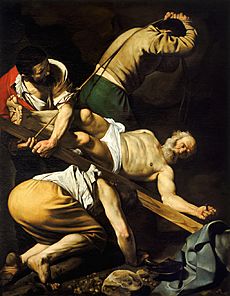
Pope Clement I (d. 99), in his Letter to the Corinthians (Chapter 5), written c. 80–98, speaks of Peter's martyrdom in the following terms: "Let us take the noble examples of our own generation. Through jealousy and envy the greatest and most just pillars of the Church were persecuted, and came even unto death. …Peter, through unjust envy, endured not one or two but many labours, and at last, having delivered his testimony, departed unto the place of glory due to him."
The apocryphal Acts of Peter (2nd cent.) (Vercelli Acts XXXV) is the source for the tradition about the famous Latin phrase "Quo vadis, Domine?" (in Greek: Κύριε, ποῦ ὑπάγεις "Kyrie, pou hypageis?"), which means "Where are you going, Lord?". According to the story, Peter, fleeing Rome to avoid execution meets the risen Jesus. In the Latin translation, Peter asks Jesus, "Quo vadis?" He replies, "Romam eo iterum crucifigi" ("I am going to Rome to be crucified again"). Peter then gains the courage to continue his ministry and returns to the city, where he is martyred. This story is commemorated in an Annibale Carracci painting. The Church of Quo Vadis, near the Catacombs of Saint Callistus, contains a stone in which Jesus' footprints from this event are supposedly preserved, though this was apparently an ex-voto from a pilgrim, and indeed a copy of the original housed in the Basilica of St Sebastian.
The death of Peter is attested to by Tertullian (c. 155 – c. 240) at the end of the 2nd century in his Prescription Against Heretics, noting that Peter endured a passion like his Lord's. “How happy is that church . . . where Peter endured a passion like that of the Lord, where Paul was crowned in a death like John’s". The statement implies that Peter was killed like Jesus (by crucifixion) and Paul was killed like John (by beheading). It gives the impression that Peter also died in Rome since Paul also died there. In his work Scorpiace 15, he also speaks of Peter's crucifixion: "The budding faith Nero first made bloody in Rome. There Peter was girded by another, since he was bound to the cross."
Origen (184–253) in his Commentary on the Book of Genesis III, quoted by Eusebius of Caesaria in his Ecclesiastical History (III, 1), said: "Peter was crucified at Rome with his head downwards, as he himself had desired to suffer." The Cross of St. Peter inverts the Latin cross based on this refusal, and on his claim of being unworthy to die the same way as his Saviour.
Peter of Alexandria (d. 311), who was bishop of Alexandria and died around AD 311, wrote an epistle on Penance, in which he says: "Peter, the first of the apostles, having been often apprehended and thrown into prison, and treated with ignominy, was last of all crucified at Rome."
Jerome (327–420) wrote that "at Nero's hands Peter received the crown of martyrdom being nailed to the cross with his head towards the ground and his feet raised on high, asserting that he was unworthy to be crucified in the same manner as his Lord."
Burial
Catholic tradition holds that Peter's inverted crucifixion occurred in the gardens of Nero, with the burial in Saint Peter's tomb nearby.
Caius in his Disputation Against Proclus (A.D. 198), preserved in part by Eusebius, relates this of the places in which the remains of the apostles Peter and Paul were deposited: "I can point out the trophies of the apostles. For if you are willing to go to the Vatican or to the Ostian Way, you will find the trophies of those who founded this Church."
According to Jerome, in his work De Viris Illustribus (A.D. 392), "Peter was buried at Rome in the Vatican near the triumphal way where he is venerated by the whole world."
In the early 4th century, the Emperor Constantine I decided to honour Peter with a large basilica. Because the precise location of Peter's burial was so firmly fixed in the belief of the Christians of Rome, the church to house the basilica had to be erected on a site that was not convenient to construction. The slope of the Vatican Hill had to be excavated, even though the church could much more easily have been built on level ground only slightly to the south. There were also moral and legal issues, such as demolishing a cemetery to make room for the building. The focal point of the Basilica, both in its original form and in its later complete reconstruction, is the altar located over what is said to be the point of Peter's burial.
Relics
According to a letter quoted by Bede, Pope Vitalian sent a cross containing filings said to be from Peter's chains to the queen of Oswy, Anglo-Saxon King of Northumbria in 665, as well as unspecified relics of the saint to the king. The skull of Saint Peter is claimed to reside in the Archbasilica of Saint John Lateran since at least the ninth century, alongside the skull of Saint Paul.
In 1950, human bones were found buried underneath the altar of St. Peter's Basilica. The bones have been claimed by many to have been those of Peter. An attempt to contradict these claims was made in 1953 by the excavation of what some believe to be Saint Peter's tomb in Jerusalem. However along with this supposed tomb in Jerusalem bearing his previous name Simon (but not Peter), tombs bearing the names of Jesus, Mary, James, John, and the rest of the apostles were also found at the same excavation—though all these names were very common among Jews at the time.
In the 1960s, items from the excavations beneath St Peter's Basilica were re-examined, and the bones of a male person were identified. A forensic examination found them to be a male of about 61 years of age from the 1st century. This caused Pope Paul VI in 1968 to announce them most likely to be the relics of Apostle Peter. On 24 November 2013, Pope Francis presented part of the relics, consisting of bone fragments, for the first time in public during a Mass celebrated in St. Peter's Square. On 2 July 2019, it was announced that Pope Francis had transferred nine of these bone fragments within a bronze reliquary to Orthodox Ecumenical Patriarch Bartholomew of Constantinople. Bartholomew, who serves as head of the Eastern Orthodox Christian church, described the gesture as "brave and bold." Pope Francis has said his decision was born "out of prayer" and intended as a sign of the ongoing work towards communion between the Orthodox and Catholic Churches. The majority of Saint Peter's remains, however, are still preserved in Rome, under the high altar of St. Peter's Basilica.
Epistles of Peter – Rome as Babylon
Church tradition ascribes the epistles First and Second Peter to the Apostle Peter, as does the text of Second Peter itself, an attribution rejected by scholarship. First Peter says the author is in "Babylon", which has been held to be a coded reference to Rome. Early Church tradition reports that Peter wrote from Rome.
If the reference is to Rome, it is the only biblical reference to Peter being there. Many scholars regard both First and Second Peter as not having been authored by him, partly because other parts of the Acts of the Apostles seem to describe Peter as an illiterate fisherman.
Most Biblical scholars believe that "Babylon" is a metaphor for the pagan Roman Empire at the time it persecuted Christians, before the Edict of Milan in 313: perhaps specifically referencing some aspect of Rome's rule (brutality, greed, paganism). Although some scholars recognize that Babylon is a metaphor for Rome, they also claim that Babylon represents more than the Roman city of the first century.
At that time in history, the ancient city of Babylon was no longer of any importance. E.g., Strabo wrote, "The greater part of Babylon is so deserted that one would not hesitate to say ... the Great City is a great desert."
Another theory is that "Babylon" refers to the Babylon in Egypt that was an important fortress city in Egypt, just north of today's Cairo and this, combined with the "greetings from Mark" (1 Peter 5:13), who may be Mark the Evangelist, regarded as the founder of the Church of Alexandria (Egypt), has led some scholars to regard the First Peter epistle as having been written in Egypt.
Scholarly views
Some church historians consider Peter and Paul to have been martyred under the reign of Nero, around AD 65 after the Great Fire of Rome. Currently, most Catholic scholars, and many scholars in general, hold the view that Peter was martyred in Rome under Nero.
While accepting that Peter came to Rome and was martyred there, there is no historical evidence that he held episcopal office there. According to two extensive studies published by the German philologist Otto Zwierlein in 2009 and 2013 respectively, "there is not a single piece of reliable literary evidence (and no archaeological evidence either) that Peter ever was in Rome."
Clement of Rome's First Letter, a document that has been dated from the 90s to the 120s, is one of the earliest sources adduced in support of Peter's stay in Rome, but Zwierlein questions the text's authenticity and whether it has any knowledge about Peter's life beyond what is contained in the New Testament Acts of the Apostles. The letter also does not mention any particular place, only saying: "Peter, through unrighteous envy, endured not one or two, but numerous labours and when he had at length suffered martyrdom, departed to the place of glory due to him" (ch. 5).
A letter to the Romans attributed to Ignatius of Antioch might imply that Peter and Paul had special authority over the Roman church, telling the Roman Christians: "I do not command you, as Peter and Paul did" (ch. 4), although Zwierlein says he could be simply referring to the Epistles of the Apostles, or their mission work in the city, not a special authority given or bestowed. Zwierlein questions the authenticity of this document and its traditional dating to c. 105–10, saying it may date from the final decades of the 2nd century instead of from the beginning.
Feast days
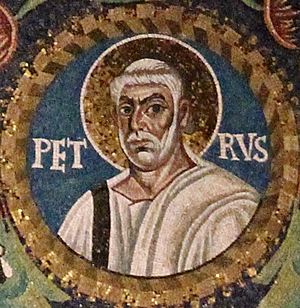
The Roman Martyrology assigns 29 June as the feast day of both Peter and Paul, without thereby declaring that to be the day of their deaths. Augustine of Hippo says in his Sermon 295: "One day is assigned for the celebration of the martyrdom of the two apostles. But those two were one. Although their martyrdom occurred on different days, they were one."
This is also the feast of both Apostles in the calendar of the Eastern Orthodox Church.
In the Roman Rite, the feast of the Chair of Saint Peter is celebrated on 22 February, and the anniversary of the dedication of the two Papal Basilicas of Saint Peter's and Saint Paul outside the Walls is held on 18 November.
Before Pope John XXIII's revision in 1960, the Roman Calendar also included on 18 January another feast of the Chair of Saint Peter (denominated the Chair of Saint Peter in Rome, while the February feast was then called that of the Chair of Saint Peter at Antioch), and on 1 August the feast of Saint Peter in Chains.
In the Orthodox Daily Office every Thursday throughout the year is dedicated to the Holy Apostles, including St. Peter. There are also three feast days in the year which are dedicated to him:
- 16 January, Veneration of the Precious Chains of the Holy and All-Glorious Apostle Peter — commemorating both the chains which Acts 12:1–11 says miraculously fell from him, and the chains in which he was held before his martyrdom by Nero.
- 29 June, Feast of Saints Peter and Paul — This is a major feast day and is preceded by a period of Lenten fasting known as the Apostles' Fast.
- 30 June, Synaxis of the Holy, Glorious and All-Praised Twelve Apostles — commemorating of Tvelve Apostles.
Peter is remembered (with Paul) in the Church of England with a Festival on 29 June, Peter the Apostle may be celebrated alone, without Paul, on 29 June.
Primacy of Peter
Christians of different theological backgrounds are in disagreement as to the exact significance of Peter's ministry. For instance:
- Catholics view Peter as the first pope. The Catholic Church asserts that Peter's ministry, conferred upon him by Jesus of Nazareth in the gospels, lays down the theological foundation for the pope's exercise of pastoral authority over the Church.
- Eastern Orthodox also believe that Peter's ministry points to an underlying theology wherein a special primacy ought to be granted to Peter's successors above other Church leaders but see this as merely a "primacy of honor", rather than the right to exercise pastoral authority.
- Protestant denominations assert that Peter's apostolic work in Rome does not imply a connection between him and the papacy.
Similarly, historians of various backgrounds also offer differing interpretations of the Apostle's presence in Rome.
Catholic Church
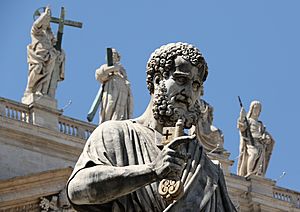
According to Catholic belief, Simon Peter was distinguished by Jesus to hold the first place of honor and authority. Also in Catholic belief, Peter was, as the first Bishop of Rome, the first Pope. Furthermore, they consider every Pope to be Peter's successor and the rightful superior of all other bishops. However, Peter never bore the title of "Pope" or "Vicar of Christ" in the sense the Catholic Church considers Peter the first Pope.
The Catholic Church's recognition of Peter as head of its church on earth (with Christ being its heavenly head) is based on its interpretation of two passages from the canonical gospels of the New Testament, as well as sacred tradition.
John 21:15–17
The first passage is John 21:15–17 which is: "Feed my lambs... Tend my sheep... feed my sheep" (within the Greek it is Ποίμαινε i.e., to feed and rule [as a Shepherd] v. 16, while Βόσκε i.e., to feed for v.15 & v. 17)—which is seen by Catholics as Christ promising the spiritual supremacy to Peter. The Catholic Encyclopedia of 1913 sees in this passage Jesus "charging [Peter] with the superintendency of all his sheep, without exception; and consequently of his whole flock, that is, of his own church".
Matthew 16:18
Etymology
Jesus later alludes to this nickname after Peter declares Jesus to be the Messiah:
κἀγὼ δέ σοι λέγω ὅτι σὺ εἶ Πέτρος [Petros] καὶ ἐπὶ ταύτῃ τῇ πέτρᾳ [petra] οἰκοδομήσω μου τὴν ἐκκλησίαν, καὶ πύλαι ᾅδου οὐ κατισχύσουσιν αὐτῆς.
I also say to you now that you are Peter, and on this rock I will build my Church, and the gates of Hades will not prevail against it.
Paul of Tarsus later uses the appellation Cephas in reference to Peter.
Epistles of Paul
Paul's Epistle to the Romans, written about AD 57. greets some fifty people in Rome by name, but not Peter whom he knew. There is also no mention of Peter in Rome later during Paul's two-year stay there in Acts 28, about AD 60–62. Some Church historians consider Peter and Paul to have been martyred under the reign of Nero, around AD 64 or 68.
Protestant rejection of Catholic claims
Other theologically conservative Christians, including Confessional Lutherans, also rebut comments made by Karl Keating and D.A. Carson who claim that there is no distinction between the words petros and petra in Koine Greek. The Lutheran theologians state that the dictionaries of Koine/NT Greek, including the authoritative Bauer-Danker-Arndt-Gingrich Lexicon, indeed list both words and the passages that give different meanings for each.
Oscar Cullmann, a Lutheran theologian and distinguished Church historian, disagrees with Luther and the Protestant reformers who held that by "rock" Christ did not mean Peter, but meant either himself or the faith of His followers. He believes the meaning of the original Aramaic is very clear: that "Kepha" was the Aramaic word for "rock", and that it was also the name by which Christ called Peter.
Yet, Cullmann sharply rejects the Catholic claim that Peter began the papal succession. He writes: "In the life of Peter there is no starting point for a chain of succession to the leadership of the church at large." While he believes the Matthew text is entirely valid and is in no way spurious, he says it cannot be used as "warrant of the papal succession." Cullmann concludes that while Peter was the original head of the apostles, Peter was not the founder of any visible church succession.
There are other Protestant scholars who also partially defend the historical Catholic position about "Rock." Taking a somewhat different approach from Cullman, they point out that the Gospel of Matthew was not written in the classical Attic form of Greek, but in the Hellenistic Koine dialect in which there is no distinction in meaning between petros and petra. Moreover, even in Attic Greek, in which the regular meaning of petros was a smallish "stone", there are instances of its use to refer to larger rocks, as in Sophocles, Oedipus at Colonus v. 1595, where petros refers to a boulder used as a landmark, obviously something more than a pebble. In any case, a petros/petra distinction is irrelevant considering the Aramaic language in which the phrase might well have been spoken. In Greek, of any period, the feminine noun petra could not be used as the given name of a male, which may explain the use of Petros as the Greek word with which to translate Aramaic Kepha.
Yet, still other Protestant scholars believe that Jesus in fact did mean to single out Peter as the very rock which he will build upon, but that the passage does nothing to indicate a continued succession of Peter's implied position. They assert that Matthew uses the demonstrative pronoun taute, which allegedly means "this very" or "this same", when he refers to the rock on which Jesus' church will be built. He also uses the Greek word for "and", kai. It is alleged that when a demonstrative pronoun is used with kai, the pronoun refers back to the preceding noun. The second rock Jesus refers to must then be the same rock as the first one; and if Peter is the first rock he must also be the second.
Unlike Oscar Cullmann, Confessional Lutherans and many other Protestant apologists agree that it's meaningless to elaborate the meaning of "Rock" by looking at the Aramaic language. While the Jews spoke mostly Aramaic at home, in public they usually spoke Greek. The few Aramaic words spoken by Jesus in public were unusual, which is why they are noted as such. And most importantly the New Testament was revealed in Koine Greek, not Aramaic.
Eastern Orthodox
The Eastern Orthodox Church regards Apostle Peter, together with Apostle Paul, as "Preeminent Apostles". Another title used for Peter is Coryphaeus, which could be translated as "Choir-director", or lead singer. The church recognizes Apostle Peter's leadership role in the early church, especially in the very early days at Jerusalem, but does not consider him to have had any "princely" role over his fellow Apostles.
The New Testament is not seen by the Orthodox as supporting any extraordinary authority for Peter with regard to faith or morals. The Orthodox also hold that Peter did not act as leader at the Council of Jerusalem, but as merely one of a number who spoke.
Eastern and Oriental Orthodox do not recognize the Bishop of Rome as the successor of St. Peter but the Ecumenical Patriarch of Constantinople sends a delegation each year to Rome to participate in the celebration of the feast of Sts. Peter and Paul. In the Ravenna Document of 13 October 2007, the representatives of the Eastern Orthodox Church agreed that "Rome, as the Church that 'presides in love' according to the phrase of St. Ignatius of Antioch ("To the Romans", Prologue), occupied the first place in the taxis, and that the bishop of Rome was therefore the protos among the patriarchs, if the Papacy unites with the Orthodox Church. They disagree, however, on the interpretation of the historical evidence from this era regarding the prerogatives of the bishop of Rome as protos, a matter that was already understood in different ways in the first millennium."
With regard to Jesus' words to Peter, "Thou art Peter and upon this rock I will build my church", the Orthodox hold Christ is referring to the confession of faith, not the person of Peter as that upon which he will build the church. This is allegedly shown by the fact that the original Septuagint uses the feminine demonstrative pronoun when he says "upon this rock" (ταύτῃ τῇ πέτρᾳ); whereas, grammatically, if he had been referring to Peter, he would allegedly have used the masculine.
Syriac Orthodox Church
The Fathers of the Syriac Orthodox Church tried to give a theological interpretation to the primacy of Apostle Peter. They were fully convinced of the unique office of Peter in the primitive Christian community. Ephrem, Aphrahat and Maruthas who were supposed to have been the best exponents of the early Syriac tradition unequivocally acknowledge the office of Peter.
The Syriac Fathers, following the rabbinic tradition, call Jesus "Kepha" for they see "rock" in the Old Testament as a messianic Symbol (yet the Old Maronite Syriacs of Lebanon still refer to Saint Peter as "Saint Simon the Generous" or Simon Karam"). When Christ gave his own name "Kepha" to Simon he was giving him participation in the person and office of Christ. Christ who is the Kepha and shepherd made Simon the chief shepherd in his place and gave him the very name Kepha and said that on Kepha he would build the Church. Aphrahat shared the common Syriac tradition. For him Kepha is in fact another name of Jesus, and Simon was given the right to share the name. The person who receives somebody else's name also obtains the rights of the person who bestows the name. Aphrahat makes the stone taken from Jordan a type of Peter. He wrote: "Jesus son of Nun set up the stones for a witness in Israel; Jesus our Saviour called Simon Kepha Sarirto and set him as the faithful witness among nations."
Again he wrote in his commentary on Deuteronomy that Moses brought forth water from "rock" (Kepha) for the people and Jesus sent Simon Kepha to carry his teachings among nations. God accepted him and made him the foundation of the Church and called him Kepha. When he speaks about the transfiguration of Christ he calls him Simon Peter, the foundation of the Church. Ephrem also shared the same view. The Armenian version of De Virginitate records that Peter the rock shunned honour. A mimro of Efrem found in Holy Week Liturgy points to the importance of Peter.
Both Aphrahat and Ephrem represent the authentic tradition of the Syrian Church. The different orders of liturgies used for sanctification of Church buildings, marriage, ordination, et cetera, reveal that the primacy of Peter is a part of living faith of the Church.
New Apostolic Church
The New Apostolic Church, which believes in the re-established Apostle ministry, sees Peter as the first Chief Apostle.
The Church of Jesus Christ of Latter-day Saints
The Church of Jesus Christ of Latter-day Saints teaches that Peter was the first leader of the early Christian church after the death and resurrection of Jesus Christ. While the Church accepts apostolic succession from Peter, it rejects papal successors as illegitimate. Joseph Smith, the founder of Mormonism, recorded in multiple revelations that the resurrected Peter appeared to him and Oliver Cowdery in 1829, near Harmony Township, Susquehanna County, Pennsylvania, in order to bestow the apostleship and keys of the kingdom as part of a restoration of priesthood authority.
In interpreting Matthew 16:13–19, Latter-day Saint leader Bruce R. McConkie stated, "The things of God are known only by the power of his Spirit," and "that which the world calls Mormonism is based upon the rock of revelation." In his April 1981 general conference address, McConkie identified the rock of which Jesus spoke as the rock of revelation: "There is no other foundation upon which the Lord could build His Church and kingdom. ...Revelation: Pure, perfect, personal revelation—this is the rock!"
Non-Christian views
Judaism
According to an old Jewish tradition, Simon Peter joined the early Christians at the decision of the rabbis. Worried that early Christianity's similarity to Judaism would lead people to mistake it for a branch of Judaism, he was chosen to join them. As he moved up in rank, he would be able to lead them into forming their own, distinct belief system. Despite this, he was said to remain a practicing Jew, and is ascribed with the authorship of the Nishmas prayer.
Islam
Muslims consider Jesus a prophet of God. The Qur'an also speaks of Jesus's disciples but does not mention their names, instead referring to them as "helpers to the prophet of God". Muslim exegesis and Qur'an commentary, however, names them and includes Peter among the disciples. An old tradition, which involves the legend of Habib the Carpenter, mentions that Peter was one of the three disciples sent to Antioch to preach to the people there.
Twelver Shia Muslims see a parallel in the figure of Peter to Ali at Muhammad's time. They look upon Ali as being the vicegerent, with Muhammad being the prophet; likewise, they see Peter as the vicegerent, behind Jesus the prophet and Masih. Peter's role as the first proper leader of the church is also seen by Shias to be a parallel to their belief in Ali as the first caliph after Muhammad.
Bahá’í Faith
In the Bahá’í Faith "the primacy of Peter, the Prince of the Apostles, is upheld and defended." Bahá’ís understand Peter's station as The Rock upon which the church of God would be founded to mean that Peter's belief in Christ as the Son of the living God would serve as the foundation for Christianity, and that upon this belief would the foundation of the church of God, understood as the Law of God, be established.
Ossetian mythology
His name with a prefix dan (related to river names) was applied to Donbettyr, the Osettian god of waters, patron of fish and fishermen.
Andean traditional medicine
San Pedro cactus (Echinopsis pachanoi) has a long history of being used in Andean traditional medicine. The common name "San Pedro cactus" – Saint Peter cactus, is attributed to the belief that as St Peter holds the keys to heaven, the effects of the cactus allow users "to reach heaven while still on earth." In 2022, the Peruvian Ministry of Culture declared the traditional use of San Pedro cactus in northern Peru as cultural heritage.
Writings
Traditionally, two canonical epistles (1 and 2 Peter) and several apocryphal works have been attributed to Peter.
Iconography
The earliest portrait of Peter dates back to the 4th century and was located in 2010. In traditional iconography, Peter has been shown very consistently since early Christian art as an oldish, thick-set man with a "slightly combative" face and a short beard, and usually white hair, sometimes balding. He thus contrasts with Paul the Apostle who is bald except at the sides, with a longer beard and often black hair, and thinner in the face. One exception to this is in Anglo-Saxon art, where he typically lacks a beard. Both Peter and Paul are shown thus as early as the 4th century Catacombs of Marcellinus and Peter in Rome. Later in the Middle Ages his attribute is one or two large keys in his hand or hanging from his belt, first seen in the early 8th century. More than many medieval attributes, this continued to be depicted in the Renaissance and afterwards. By the 15th century Peter is more likely to be bald on the top of his head in the Western church, but he continues to have a good head of hair in Orthodox icons.
The depiction of Saint Peter as literally the keeper of the gates of heaven, popular with modern cartoonists, is not found in traditional religious art, but Peter usually heads groups of saints flanking God in heaven, on the right side (viewer's left) of God. Narrative images of Peter include several scenes from the Life of Christ where he is mentioned in the gospels, and he is often identifiable in scenes where his presence is not specifically mentioned. Usually he stands nearest to Christ. In particular, depictions of the Arrest of Christ usually include Peter cutting off the ear of one of the soldiers. Scenes without Jesus include his distinctive martyrdom, his rescue from prison, and sometimes his trial. In the Counter-Reformation scenes of Peter hearing the cock crow for the third time became popular, as a representation of repentance and hence the Catholic sacrament of Confession or Reconciliation.
Patronage
| Workers | ||
|---|---|---|
|
|
|
| Called for aid in | ||
|
||
| Institutions | ||
|
|
|
| Churches and Cathedrals | ||
| Locations | ||
|
|
|
Revisionist views
L. Michael White suggests that there was a serious division between Peter's Jewish Christian party and Paul's Hellenizing party, seen in e.g. the Incident at Antioch, which later Christian accounts have downplayed.
Another revisionist view was developed by supporters of the Christ myth theory, which holds that the figure of Peter is largely a development from some mythological doorkeeper figures. According to Arthur Drews and G. A. Wells, if there was a historical Peter, then all that is known about him is the brief mentions in Galatians.
In art
- Depictions of Saint Peter
-
Saint Peter Attempting to Walk on Water, by François Boucher, 1766
-
The Release of St. Peter by Bernardo Strozzi, 1635
-
Jesus gives Peter the keys to Heaven by Peter Paul Rubens, 1614
-
Peter Enthroned, by Arnolfo di Cambio (13th-century statue in St Peter's Basilica, Rome)
-
The Miraculous Draught of Fishes, by Raphael, 1515
-
Jesus calling Simon Peter and Andrew by Duccio di Buoninsegna, 1308–1311
-
Alessandro Turchi, Saint Agatha Attended by Saint Peter and an Angel in Prison, 1640–1645
-
Fresco by Pietro Perugino in the Sistine Chapel, 1480–1482
-
Statue of Saint Peter (c. 1510–1520) at the V&A
In music
- Rolland de Lassus, Les Larmes de Saint Pierre, 21 spiritual madrigals (1594).
- Marc-Antoine Charpentier, Le Reniement de Saint Pierre H.424, for soloists, chorus and continuo (date unknown).
See also
 In Spanish: Simón Pedro para niños
In Spanish: Simón Pedro para niños
- Apocalypse of Simeon Kepha
- List of Catholic saints
- List of biblical figures identified in extra-biblical sources
- List of popes
- Saint Peter and Islam
- Saint Peter and Judaism
- Saint Peter's Square
- Saint Peter's tomb
- San Pietro in Vincoli
- St. Peter's Basilica
- Sword of Saint Peter



